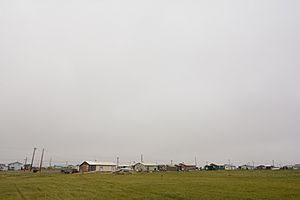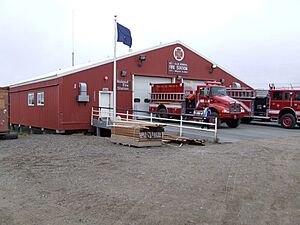Nuiqsut, Alaska facts for kids
Quick facts for kids
Nuiqsut
Nuiqsut
|
|
|---|---|

A row of homes in the center of Nuiqsut, Alaska
|
|
| Country | United States |
| State | Alaska |
| Borough | North Slope |
| Incorporated | June 24, 1975 |
| Area | |
| • Total | 8.89 sq mi (23.02 km2) |
| • Land | 8.89 sq mi (23.02 km2) |
| • Water | 0.00 sq mi (0.00 km2) |
| Elevation | 23 ft (7 m) |
| Population
(2020)
|
|
| • Total | 512 |
| • Density | 57.61/sq mi (22.24/km2) |
| Time zone | UTC-9 (Alaska (AKST)) |
| • Summer (DST) | UTC-8 (AKDT) |
| ZIP code |
99789
|
| Area code | 907 |
| FIPS code | 02-56320 |
| GNIS feature ID | 1416680, 2419439 |
Nuiqsut (Inupiaq: Nuiqsat, IPA: [nuiχsɐt]) is a small city in the North Slope Borough of Alaska, United States. In 2020, about 512 people lived there. Most of them (92.5%) are Alaska Native people.
Nuiqsut is in an area with a lot of oil. It is the closest community to a big oil drilling project called the Willow Project. This project is run by ConocoPhillips in the Alpine, Alaska oil field. The people of Nuiqsut own the land on top (surface rights) where some oil is found. However, another group, the Arctic Slope Regional Corporation, owns the oil deep underground (subsurface rights).
Contents
Where Nuiqsut Is Located
Nuiqsut is found at 70°12′59″N 151°0′21″W / 70.21639°N 151.00583°W. It is in the North Slope Borough on the Nechelik Channel. This is about 35 miles (56 km) from the Beaufort Sea coast.
The city is located on the Colville River. It is about 5 miles (8 km) north of where the Colville River meets the Itkillik River.
The city covers about 9.2 square miles (23.02 km2) of land. You can only get to Nuiqsut by flying to the Nuiqsut Airport for most of the year. In winter, people can also use an ice road. Nuiqsut is about 10 miles (16 km) south of Alpine, Alaska. It is also about 80 miles (129 km) west of Prudhoe Bay, Alaska.
People of Nuiqsut
| Historical population | |||
|---|---|---|---|
| Census | Pop. | %± | |
| 1980 | 208 | — | |
| 1990 | 354 | 70.2% | |
| 2000 | 433 | 22.3% | |
| 2010 | 402 | −7.2% | |
| 2020 | 512 | 27.4% | |
| U.S. Decennial Census | |||
Nuiqsut became an official city in 1975. The first time it was counted in the U.S. Census was in 1980.
In 2000, there were 433 people living in Nuiqsut. There were 110 households, and 90 of them were families. Many households (54.5%) had children under 18 living with them. The average household had about 3.93 people.
By 2010, the population was 402 people. Most residents (87.1%) were Native American. About 10.0% were White.
The population was quite young. In 2000, 42.0% of the people were under 18 years old. The average age was 24 years.
Local Businesses and Community Places
Nuiqsut has one main store where people can buy things. There is also a place to pick up mail, which is run by the city. The community has one church, which is Presbyterian.
Other important places for people to gather include the city's recreation center and the school. There is also a living center for elders, which are older community members.
Since 1973, Nuiqsut has its own Alaska Native corporation called "Kuukpik." More than 600 people are part of this corporation.
Before 2001, the people of Nuiqsut mostly lived by hunting and fishing. This is called a subsistence-based economy. When ConocoPhillips found oil and gas nearby, Kuukpik, the local corporation, made an agreement for the oil company to use the land. Since oil production started in 2001, Kuukpik has received a small payment from ConocoPhillips. This was the first time a Native village was affected this way by oil.
Since 2018, ConocoPhillips has wanted to develop the Willow project oil field. Kuukpik has asked for changes to this project. They want fewer drill sites and shorter gravel roads. They also want to protect Teshekpuk Lake. In 2023, the mayor of Nuiqsut, Rosemary Ahtuangaruak, spoke against the project. She was worried about how it would affect caribou and the traditional way of life.
Education in Nuiqsut
Nuiqsut has one school called Nuiqsut Trapper School. It is part of the North Slope Borough School District. Students from kindergarten all the way to 12th grade attend this school. It also has a preschool program.
There are about 100 students at the school. Around 12 teachers and 6 other staff members work there. The school is a very important place for the community. Many events are held there. It also serves as a safe place for the community during emergencies, like power outages.
Culture and History
The native people of Nuiqsut are called Iñupiat. In the early 1970s, the village was re-established. The residents moved to this area from Utqiaġvik. For a year, they lived in tents while their homes were being built. These original residents were the first to receive payments from oil companies for using their land. These payments are often passed down from parents to their children.
Traditional activities like hunting are still important. People hunt whales, caribou, foxes, and ptarmigan. They also continue to make traditional clothes and crafts. The bowhead whale is a very important animal hunted by the whalers of Nuiqsut. While modern life has changed things, these traditions are still a big part of their culture.
In 2022, a gas leak in the area caused some villagers to leave their homes for a short time.
In 2023, officials in Nuiqsut spoke out against the Bureau of Land Management (BLM). They felt the BLM did not give enough time for people to share their thoughts on the Willow project.
Natural Resources
Nuiqsut is in an area with a lot of oil. Many large oil companies, like ConocoPhillips and Hilcorp, have oil facilities nearby. The oil companies pay the native residents of Nuiqsut (the Inupiat Eskimos) to use their land. For many residents, these payments are a main source of income.
However, the oil development and climate change are affecting their traditional way of life. Permafrost (ground that is always frozen) is thawing, and sea levels are rising. The Arctic Ocean is also getting warmer. These changes make it harder for them to hunt, fish, and whale. The people of Nuiqsut face a challenge: balancing the money from oil with keeping their traditional culture alive.
Climate
| Climate data for Nuiqsut, Alaska (Nuiqsut Airport), 1991–2020 normals, extremes 1998–present | |||||||||||||
|---|---|---|---|---|---|---|---|---|---|---|---|---|---|
| Month | Jan | Feb | Mar | Apr | May | Jun | Jul | Aug | Sep | Oct | Nov | Dec | Year |
| Record high °F (°C) | 35 (2) |
38 (3) |
34 (1) |
44 (7) |
67 (19) |
82 (28) |
84 (29) |
88 (31) |
67 (19) |
50 (10) |
38 (3) |
36 (2) |
88 (31) |
| Mean maximum °F (°C) | 18.5 (−7.5) |
22.9 (−5.1) |
16.5 (−8.6) |
30.3 (−0.9) |
45.8 (7.7) |
71.0 (21.7) |
75.9 (24.4) |
68.3 (20.2) |
58.5 (14.7) |
38.8 (3.8) |
28.0 (−2.2) |
24.0 (−4.4) |
77.3 (25.2) |
| Mean daily maximum °F (°C) | −8.5 (−22.5) |
−8.6 (−22.6) |
−6.9 (−21.6) |
9.9 (−12.3) |
29.2 (−1.6) |
49.9 (9.9) |
57.9 (14.4) |
51.1 (10.6) |
39.8 (4.3) |
24.0 (−4.4) |
8.2 (−13.2) |
−3.5 (−19.7) |
20.2 (−6.6) |
| Daily mean °F (°C) | −15.7 (−26.5) |
−15.7 (−26.5) |
−14.2 (−25.7) |
2.3 (−16.5) |
24.1 (−4.4) |
42.3 (5.7) |
49.5 (9.7) |
44.4 (6.9) |
34.8 (1.6) |
18.5 (−7.5) |
1.2 (−17.1) |
−10.2 (−23.4) |
13.4 (−10.3) |
| Mean daily minimum °F (°C) | −23.0 (−30.6) |
−22.8 (−30.4) |
−21.4 (−29.7) |
−5.3 (−20.7) |
19.0 (−7.2) |
34.7 (1.5) |
41.2 (5.1) |
37.7 (3.2) |
29.7 (−1.3) |
13.1 (−10.5) |
−5.9 (−21.1) |
−16.9 (−27.2) |
6.7 (−14.1) |
| Mean minimum °F (°C) | −44.6 (−42.6) |
−44.1 (−42.3) |
−40.3 (−40.2) |
−25.7 (−32.1) |
0.3 (−17.6) |
25.9 (−3.4) |
32.9 (0.5) |
30.5 (−0.8) |
19.2 (−7.1) |
−5.1 (−20.6) |
−25.2 (−31.8) |
−38.1 (−38.9) |
−48.0 (−44.4) |
| Record low °F (°C) | −62 (−52) |
−56 (−49) |
−53 (−47) |
−39 (−39) |
−23 (−31) |
21 (−6) |
29 (−2) |
25 (−4) |
5 (−15) |
−21 (−29) |
−46 (−43) |
−50 (−46) |
−62 (−52) |
| Average precipitation inches (mm) | 0.32 (8.1) |
0.20 (5.1) |
0.15 (3.8) |
0.40 (10) |
0.38 (9.7) |
0.57 (14) |
1.14 (29) |
1.21 (31) |
0.58 (15) |
0.16 (4.1) |
0.26 (6.6) |
0.31 (7.9) |
5.68 (144.3) |
| Average precipitation days (≥ 0.01 in) | 0.0 | 0.9 | 1.0 | 1.2 | 4.1 | 4.6 | 8.5 | 11.4 | 8.9 | 2.2 | 0.8 | 0.3 | 43.9 |
| Source 1: NOAA | |||||||||||||
| Source 2: National Weather Service (mean maxima and minima, precip days 2006–2020) | |||||||||||||
See also
 In Spanish: Nuiqsut para niños
In Spanish: Nuiqsut para niños



